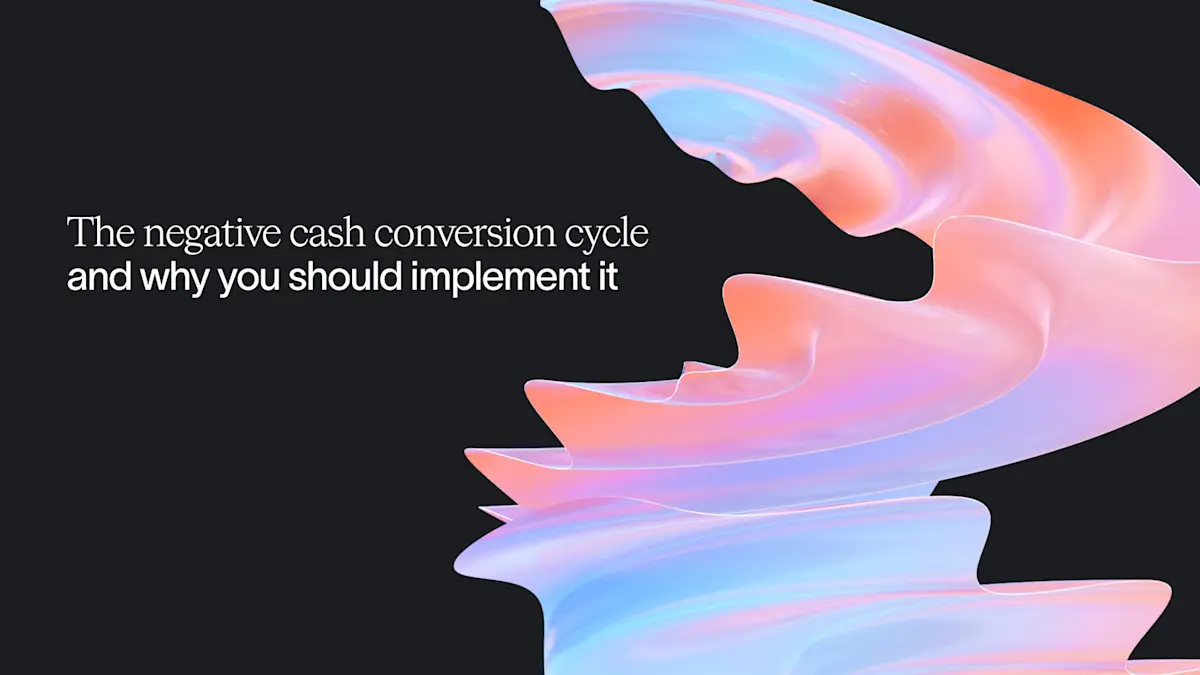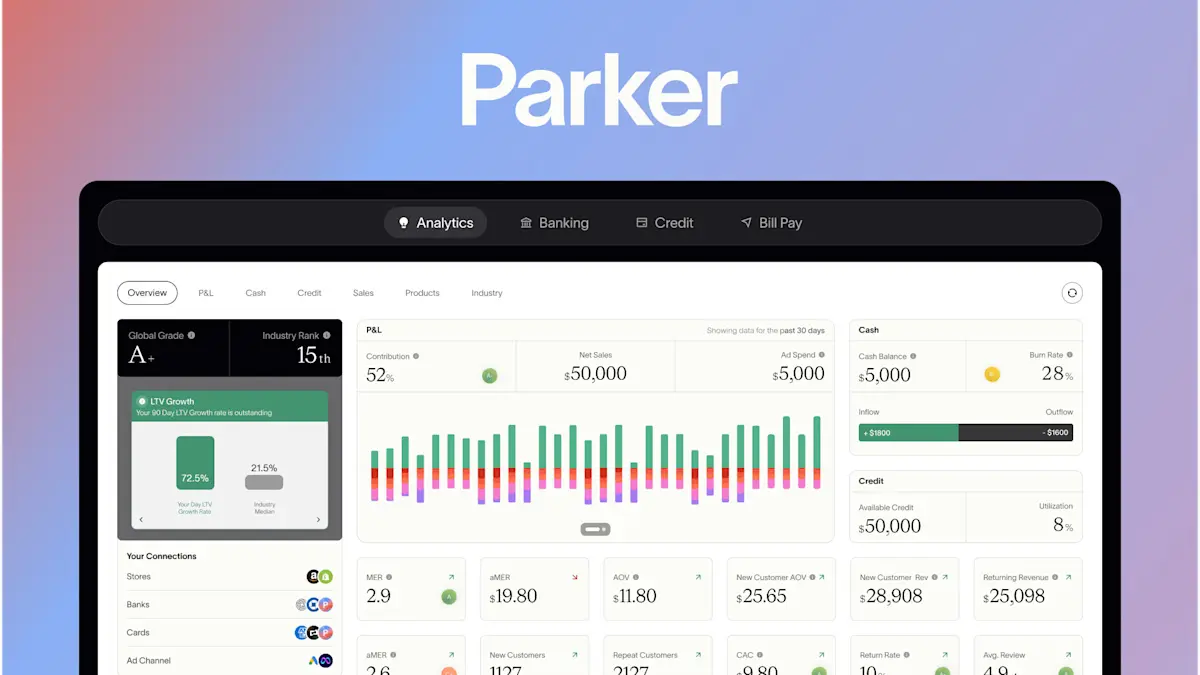Why E-commerce Businesses Should Aim For A Negative Cash Conversion Cycle

As a DTC e-commerce operator, you know that cash is king. Strong cash flow management and working capital management put you in the driver's seat when it comes to equity in your business. That means more money in your pocket today and potentially much more in your pocket if or when you exit the business.
Look at e-commerce giants like Amazon and Walmart (or newer brands, like Gymshark and Spikeball) — they manage to keep cash flowing steadily despite rapid, continuous growth in part because they employ something called negative cash conversion cycles (negative CCC). This metric is crucial for assessing a company's financial health and operational efficiency.
So, what exactly is a negative cash conversion cycle, and how can you implement it in your own DTC business to improve your supply chain and payment processes?
In this article, we break it all down step by step, exploring the cash conversion cycle formula and what a negative cash conversion cycle means for your small business.
What is the Cash Conversion Cycle?
Before we talk about achieving a negative CCC, let's make sure we understand what a cash conversion cycle actually measures.
The cash conversion cycle quantifies the amount of time between when a business has to invest cash into things like raw materials and inventory until the point when it receives customer payment for the goods. Typically measured in number of days, an easy way to calculate your cash conversion cycle is:
Cash Conversion Cycle = Days Inventory Outstanding + Days Sales Outstanding - Days Payable Outstanding
This formula helps you assess the average number of days it takes for your company's cash to flow through the entire operating cycle.
Breaking this down:
- Days Inventory Outstanding (DIO) measures how many days a business holds onto inventory before turning that stock into sales. It's calculated using the cost of goods sold (COGS) and average inventory values from your income statement and balance sheet.
- Days Sales Outstanding (DSO) captures how many days on average the business waits after a sale to collect payment from customers. This metric focuses on credit sales and the collections process.
- Days Payable Outstanding (DPO) measures how swiftly the company pays its own expenses, reflecting the average accounts payable period.
A good cash conversion cycle benchmark varies by industry, but generally, a lower CCC or even a negative CCC indicates better business operations and financial health.
Example: Wayfair
Wayfair IPO'd in 2014 with a $3 billion dollar valuation. Here's what their cash conversion cycle looks like:
- Days Inventory Outstanding (DIO) — 6 days
- Days Sales Outstanding (DSO) — 5 days
- Days Payables Outstanding (DPO) — 45 days
Wayfair Cash Conversion Cycle = 6 days + 5 days - 45 days = - 34 days
By keeping inventory turnover extremely fast (minimizing the time between beginning inventory and ending inventory) and negotiating extended payment terms for expenses, Wayfair maintains a substantial negative cash conversion cycle. This enables strong and consistent cash flow.
Generally, you want to minimize the time between outflows and inflows. But some companies like Wayfair take cash conversion optimization to the next level by flipping the cycle negative. A shorter cash conversion cycle or shorter CCC often indicates better operational efficiency.
So what exactly does it mean when the cash conversion cycle turns negative?
Achieving a Negative Cash Conversion Cycle
E-commerce retailers like Amazon and Walmart have massive scale and bargaining power that allows them to achieve a negative cash conversion cycle. This simply means collecting payments from customers before their own payments to suppliers and vendors come due, resulting in less time that working capital is tied up in business operations.
But you don't have to be an Amazon or Walmart to achieve a negative cash conversion cycle in your ecom brand. Even a small business can work towards this goal.
Moving to a negative cash conversion cycle typically revolves around these areas:
1. Extending Payment Terms with Suppliers
Getting longer payment terms is the #1 most effective way to shift towards a negative cash conversion cycle.
Rather than the typical 30 days, try to negotiate 60, 90, or even 120-day payment terms with vendors and suppliers wherever possible. This stretches out outflows while sales revenues continue to steadily build up your inflowing cash balance.
It takes a concerted effort in persuasion and negotiation, but the rewards are worth it.
For example, Native Deodorant founder Moiz Ali bootstrapped his company using no external funding in part by consistently calling suppliers after growth milestones to negotiate extended payment terms. This gave him enough runway and cash availability to eventually sell Native for 9 figures.
2. Reduce Days Sales Outstanding
For e-commerce businesses, accounts receivable balances are typically low or nonexistent—most customers prepay at checkout. However, you can effectively achieve negative accounts receivable by:
- Taking customer preorders
- Offering annual subscription memberships
- Batching inventory orders based on sales rather than keeping excess stock
In essence, you get paid by the customer before having to pay expenses out of pocket. The customer is funding your operations, leading to that desirable negative cash conversion cycle scenario.
Let's walk through a few examples of how preorder and membership revenue programs can contribute to a negative cash conversion cycle:
Preorder Example:
- Outdoor gear company Nature Calls wants to launch a new high-performance camping tent but lacks working capital to order inventory upfront
- Nature Calls opens up preorders for the tent at a $299 price point 2 months before the production round begins
- $100K in preorder revenue lets ABC finance the first tent production run
- Tents are then dropshipped to customers
- Nature Calls gets paid before having to pay for the tents from their manufacturer
Membership Example:
- DTC athleisure brand Comfee Cozee offers a $99 annual subscription for discounted prices
- Instead of discounting individual purchases, customers prepay upfront
- Comfee Cozee now has working capital to place bulk inventory orders
- Even if the customer ends up not buying anything, their membership fee funded scaling
3. Finance Purchase Orders
If you have a cash flow shortage but still want to be able to complete an abundance of orders coming in, there are financing options you can use to sustain your operation.
Purchase order financing gives you the ability to pay your suppliers for the products you need to fulfill outstanding customer orders.
With Parker, you can get performance-based underwriting that can give you access to credit limits much higher than traditional business cards, flexible repayment options, a full credit period on every swipe, with terms up to 90 days.
Other options you can use include paying purchase orders with Settle.co, Kickfurther, or Floatpay. These solutions can give you another 60-120 days to fulfill your obligations with suppliers, and make it so that your invoices are paid up front, while you pay this back as your products sell.
4. Lower Inventory Costs
Excess inventory can tie up precious working capital. Try these approaches to lighten the inventory load:
- Dropshipping: have suppliers hold inventory until orders are placed
- SKU optimization: only keep best-selling items on-hand
- Inventory prepayments: negotiate consigned inventory agreements where you're only billed once items ship to customers
Case Study: Skinny Pasta
Founder Bryan Guadagno leveraged a negative cash conversion cycle to rapidly scale SkinnyPasta, a low-carb/low-glycemic pasta brand:
- He negotiated up to 120 days to pay suppliers after receiving inventory
- Strong contribution margins on high-velocity products funded operating expenses
- Data-driven marketing kept CAC low, leading to excellent unit economics
- Prepayment programs helped offset inventory costs
SkinnyPasta now generates over $10M in sales and has achieved 100%+ YoY growth every year since 2020. The negative cash conversion cycle was instrumental in minimizing external funding needs.
Implementing a Negative Cash Conversion Cycle
Like Bryan's success with Skinny Pasta illustrates, running a consumer brand with a sustainable negative cash conversion cycle takes careful planning and execution across business units:
- Finance: Forecast cash flow needs, negotiate extended vendor terms, leverage inventory/PO financing options
- Product: Dropshipping to reduce inventory costs, take preorders to collect cash upfront
- Marketing: Keep CAC comfortable relative to LTV through targeted, data-driven tactics
- Operations: Optimize days inventory outstanding through demand planning, lean inventory management
While a negative cash conversion cycle isn't easy to implement, the benefits make it well worth the effort to organize your entire business around achieving it:
- Minimizes the need for external funding
- Maximizes liquidity for growth and flexibility
- Lowers working capital requirements
- Enables reinvesting revenue into scaling efforts
By putting each area of your business to work on compressing the cash conversion lifecycle, you can aspire your e-commerce brand to execute like retail giants nearly 10,000 times your size. You compress the time between investment and returns closer to zero, creating a self-funding growth machine.
You can't have long-term sustainability without mastering cash flow—implementing a negative cash conversion cycle provides that sustainability today so you can continue rapidly scaling growth tomorrow.
Related Articles
Ready to Join the Financial Revolution?




